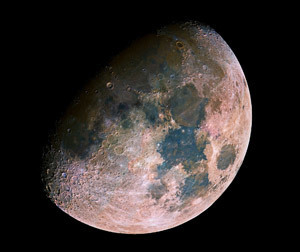
Looking at pictures of the Moon, even from the historic “giant leap” photograph, it is easy to understand why scientists used to think of it as a big dust ball. However, “conventional wisdom” has been changing over the years. This is largely due to the information garnered from missions such as NASA’s 2009 Lunar Crater Observation and Sensing Satellite (L-CROSS) lunar-impact probe, as well as new scanning technologies and more precise measurements, which have been facilitated by enhanced instrumentation and improved analytical detection limits, on samples returned to Earth following the Apollo missions.
In a paper published in the Feb. 17 issue of Nature Geoscience, researchers Hejiu Hui, postdoctoral research associate of civil and environmental engineering and earth sciences at the University of Notre Dame; Anne H. Peslier, scientist at Jacobs Technology and manager of the electron microprobe at the Astromaterials Research and Exploration Science Division at Johnson Space Center; Youxue Zhang, the James R. O’Neil Collegiate Professor of Earth and Environmental Sciences at the University of Michigan; and Clive R. Neal, professor of civil and environmental engineering and earth sciences at Notre Dame, show that they have detected significant amounts of water in the samples of the lunar highland upper crust obtained during the Apollo missions. The lunar highlands are thought to represent the original crust, crystallized from a mostly molten early Moon that is called the lunar magma ocean.
Their findings indicate that the early Moon was not only wet, but also the water that was there was not substantially lost during the Moon’s formation. This new evidence seems to contradict the predominant lunar formation theory — that the Moon was formed from debris generated during a giant impact between Earth and another planetary body, approximately the size of Mars. According to Hui, “the presence of water in the early Moon needs to be reconciled with the favored formation scenario that had been supported by the volatile elements and isotopes in the samples, such as zinc.”
As little as five years ago, no one had detected water in the samples returned from the Moon. The advancement of instrumentation, such as secondary ion mass spectrometry and Fourier transform infrared spectroscopy, has made it possible to detect tiny, but measureable, amounts of water in the mineral grains from Apollo samples. “It’s not ‘liquid’ water that was measured during these studies but hydroxyl groups (developed from water that did exist in the lunar magma ocean) that was distributed within mineral grain,” says Hui. “We are able to detect those hydroxyl groups in the crystalline structure of the Apollo samples.”
The hydroxyl groups the team detected are evidence that the lunar interior contained significant water during the Moon’s early molten state, before the crust solidified, and that they may have played a key role in the development of lunar basalts. “The presence of water,” says Hui, “could imply a more prolonged solidification of the lunar magma ocean than the once popular anhydrous moon scenario suggests.”
Contact: Clive R. Neal, 574-631-8328, Clive.R.Neal.1@nd.edu